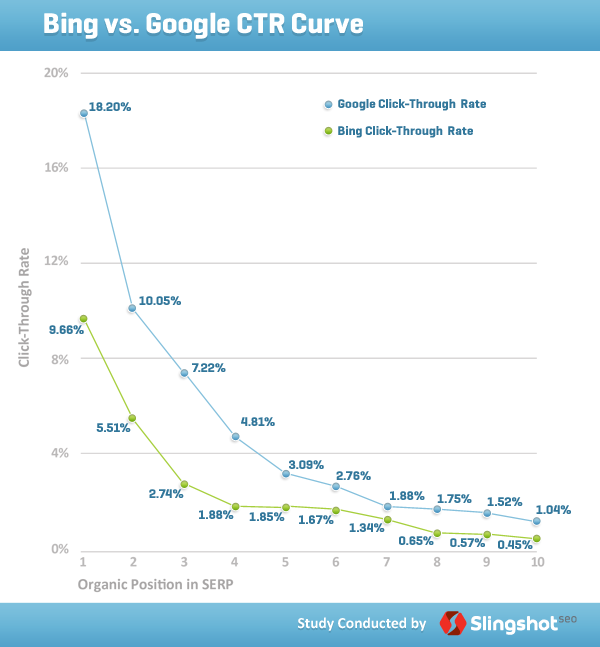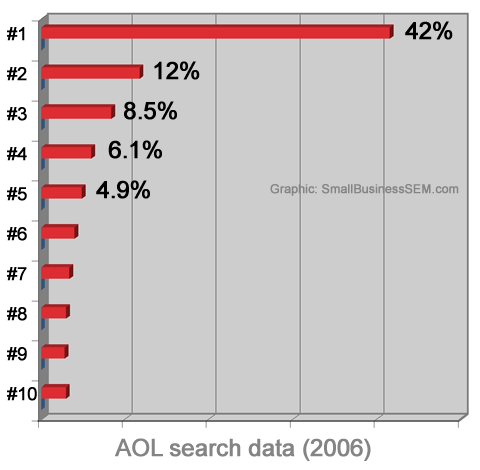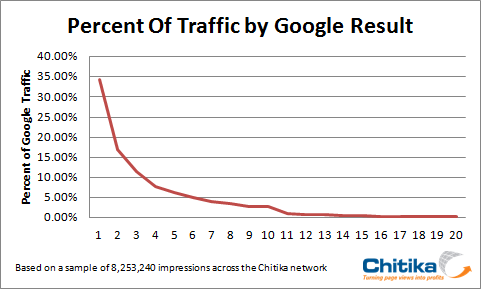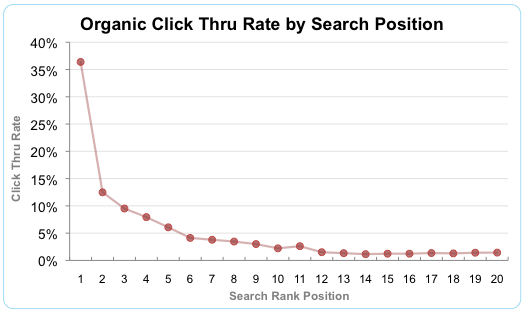Organic Click-Thru Rates Tumbling; Only 52% Click On Page One, Study Suggests
Only 52% of Google users click on an organic search result found on page one, and only 26% of Bing users do the same. Those stats are from A Tale of Two Studies: Establishing Google & BING Click-Through Rates, a new report from search agency Slingshot SEO. And they’re substantially lower than several prior CTR […]
Only 52% of Google users click on an organic search result found on page one, and only 26% of Bing users do the same. Those stats are from A Tale of Two Studies: Establishing Google & BING Click-Through Rates, a new report from search agency Slingshot SEO. And they’re substantially lower than several prior CTR studies.
According to Slingshot’s research, a number one ranking on Google gets about an 18% click-thru rate and the number two organic listing gets about 10% CTR. Both of those are about double the CTRs of comparable organic listings on Bing — 9.66% and 5.51%, respectively.
Slingshot measured click-thrus on both search engines for 624 non-branded keywords between January and July of this year. The company identified a selection of keywords that showed stable rankings for 91 of its clients, which include large retailers and other enterprise-level clients.
This is the latest in a handful of attempts at measuring click-thru rates in organic search listings, and might be the most debated — largely because the numbers in Slingshot’s study are dramatically lower than previous CTR studies.
History Of CTR Studies
AOL Data, 2006
The first real chance that search marketers had to examine click-thru rates on organic search results came after AOL released 20 million search queries made by more than a half-million users in 2006.
Based on that data, a number one ranking was worth about 42% of clicks, a number two was worth about 12% and ranking third was worth about 8.5% CTR. The 42% CTR for being number one is dramatically higher than the Slingshot study’s figures, but the CTR for lower positions are fairly similar.
The AOL data showed that the top 10 search results combined to get just less than 90% of all clicks — substantially higher than Slingshot’s 52% for Google and 26% for Bing.
Enquiro, 2007
In 2007, Enquiro (now known as Mediative) did a small CTR study that focused on the B2B market. The study is referenced about halfway down this blog post. Enquiro’s CTR figures were lower than the AOL data suggested a year earlier.
Enquiro’s data showed number one rankings getting about 25% of clicks, with CTR dropping to about 11% and 8% for the second and third positions, respectively. Overall, Enquiro’s study showed page one getting about 73% CTR.
In its blog post from last year, Enquiro goes on to say that it has “conducted additional research which suggests that the CTR is most likely around 26% for top organic, 12.68% for position two and 8.89% for third organic spot.”
Chitika, May 2010
About a year-and-a-half ago, the online ad network Chitika published its own study of organic CTRs from Google. Chitika examined Google traffic — 8.2 million impressions — coming into its network of advertiser sites and organized that traffic based on Google placement.
The Chitika data shows the top three search results combining for almost 63% CTR, with the entire top ten broken down like this:
- 34.35%
- 16.96%
- 11.42%
- 7.73%
- 6.19%
- 5.05%
- 4.02%
- 3.47%
- 2.85%
- 2.71%
Chitika’s study credited page one of Google’s search results with a total CTR of almost 95 percent.
Optify, December 2010
Earlier this year, Optify published its results from a December 2010 study of Google CTRs covering both B2C and B2B websites.
Optify’s study showed a 36.4% CTR for the number one result in Google, followed by 12.5% and 9.5% for the second and third spots, respectively. Again, the top spot has a much higher CTR than in the Slingshot study, but other positions aren’t dramatically different.
Optify’s overall CTR for page one is about 89%, much higher than what Slingshot found for both Google and Bing.
Are CTRs Dropping? Why?
The search results page has changed dramatically since 2006 when AOL’s search data became public. In May 2007, Google launched Universal Search, which added news results, images, videos, local business listings with maps and a variety of other content types beyond the traditional 10 blue links. Last year, Google added Instant Search, a feature that changed the search results page while users typed in the search box.
Both of those, along with countless other features/tools, have changed the way in which searchers interact with search results. (Think about the amount of queries that have instant answers and don’t even require a click.)
When Bing launched in 2009, its search results page was anything but typical, too. Bing organized search results into categories and showed a lot more than 10 links on page one. It also shows Related Searches and Search History links above the fold, giving users several click options outside of the actual search results. Bing’s web page previews — that Google has since copied — also mean that searchers can sometimes get the info they want without having to click on the search result.
Slingshot’s study aimed to measure the impact of new search results on CTR, but it “failed to prove that there are significant differences in user behavior regarding blended versus non-blended results.”
Slingshot’s conclusion: “The effect of blended results on user behavior remains to be seen.”
Yes, the search results page has changed. Yes, raw search numbers are going up. It could be that any CTR study will produce results that are unique to the keywords/industries that the study covers — i.e., if Slingshot had studied non-retail and non-enterprise keywords, CTRs might be quite different.
Ultimately, there’s no easy explanation for why click-thru rates are so much lower in this study than in past attempts to measure organic CTR.
The full report is available on Slingshot SEO’s website. Name and email address are required for the download.
Contributing authors are invited to create content for Search Engine Land and are chosen for their expertise and contribution to the search community. Our contributors work under the oversight of the editorial staff and contributions are checked for quality and relevance to our readers. The opinions they express are their own.
Related stories
New on Search Engine Land





